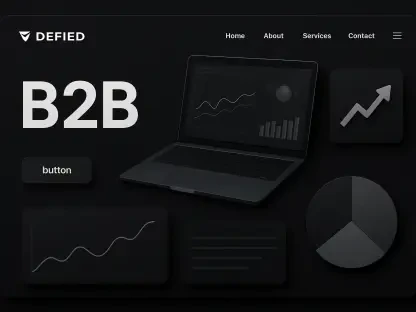Unveiling a New Era in Digital Advertising
In the ever-changing world of digital marketing, a dramatic shift is taking place as Google’s AI Overviews take over search engine results pages (SERPs), claiming the most valuable spots and challenging the foundation of paid search strategies. These AI-generated summaries, placed at the top of search results, are not just answering user questions but are fundamentally changing how brands connect with their audiences, with click-through rates (CTRs) for paid ads potentially dropping by 8–12 percentage points. This market analysis explores the transformative impact of AI Overviews on paid search advertising, delving into current trends, data-driven insights, and projections for the evolving digital ad space. The purpose of this examination is to equip advertisers with a clear understanding of the challenges and opportunities presented by this innovation, ensuring they can navigate a landscape where visibility is increasingly competitive. By analyzing comprehensive data across multiple industries, this discussion aims to illuminate the path forward for brands striving to maintain relevance in an AI-driven search environment.
Market Dynamics: Dissecting AI Overviews’ Influence on Paid Search
Current Trends: Visibility Challenges and SERP Displacement
The rise of AI Overviews marks a crucial turning point for paid search, as these summaries push traditional paid ads below the fold, significantly reducing their visibility on SERPs. Data spanning over 21 million search indexes reveals a relative decline in CTRs for paid placements by 20–40%, a trend that is especially pronounced in high-stakes industries like Finance and Retail. This displacement stems from the prominent positioning of AI-generated content, which often resolves user queries without requiring further clicks, leaving advertisers struggling with reduced traffic to their campaigns. The immediacy of these summaries captures user attention right away, creating a barrier for brands that have long relied on top-of-page ad placements to drive conversions.
Moreover, the scope of AI Overviews extends beyond mere positioning, as their presence is growing across various query types. Initially focused on informational searches, these summaries now appear for high-intent commercial keywords, directly competing with pay-per-click (PPC) ads that have historically dominated such spaces. This encroachment signals a broader shift in how search engines prioritize content, favoring synthesized responses over traditional ad formats, and poses a critical challenge for advertisers aiming to maintain their market share.
Industry-Specific Impacts: Divergent Effects Across Sectors
The impact of AI Overviews is not uniform, with distinct variations emerging across key industries such as Finance, Retail, Healthcare, Travel, and Automotive. In Finance and Retail, the penetration of AI summaries is notably high, with growth rates of 9.9% and up to 84% for long-tail queries in Retail, driven by the commercial nature of searches in these sectors. These industries face intense disruption as AI responses capture user intent on keywords that typically convert at high rates, forcing brands to rethink their bidding strategies to counteract lost visibility.
Conversely, Healthcare shows a saturated but cautious adoption of AI Overviews, with an 8.3% growth rate but a 21% pullback on complex medical queries due to sensitivity concerns. Travel and Automotive, with more moderate increases of 5.8% and around 2% respectively, reflect slower but steady integration, particularly for planning and research-oriented searches. These disparities highlight a nuanced market reality where some sectors face immediate threats, while others present untapped opportunities for brands to establish dominance in less crowded SERP spaces, provided they act quickly with tailored content strategies.
Data Insights: Query Lengths and Intent Recognition
A deeper dive into search patterns reveals a strong correlation between query length and the frequency of AI Overviews, alongside Google’s improving ability to interpret user intent. Longer queries, often 9–10 words, trigger AI summaries at the highest rates, with Retail peaking at 84% and Finance at 79%, reflecting a preference for detailed, informational content. However, a significant uptick in AI responses for shorter, 3–5 word commercial searches, especially in Finance with a 10–15% growth across query lengths, underscores an evolving competitive landscape where even high-intent searches are no longer safe havens for paid ads.
This shift in intent recognition suggests that Google’s algorithms are increasingly skilled at addressing commercial needs directly through AI content, compressing the traditional marketing funnel. Brands that once relied on PPC ads for bottom-of-funnel conversions now find themselves competing with summaries that offer immediate answers, necessitating a strategic pivot toward content that aligns with or complements these AI-driven responses. The data paints a clear picture of a market in flux, where adaptability to query trends will be a defining factor for success.
Future Projections: Expansion and Integration of AI in Search
Looking ahead, the trajectory of AI Overviews indicates a continued expansion across all industries and query types, cementing their role as a permanent fixture in the search ecosystem. Projections based on current growth patterns suggest that visibility for AI-generated content will increase, with commercial queries facing heightened competition from summaries over the next few years, from 2025 to 2027. This evolution could further erode the effectiveness of traditional paid search models, pushing advertisers to allocate budgets toward alternative channels or innovative formats.
Technological advancements in intent recognition are expected to refine the precision of AI Overviews, potentially leading to greater encroachment on paid ad territory. Additionally, regulatory oversight in sensitive sectors like Healthcare may temper the deployment of AI summaries for certain topics, creating a patchwork of adoption rates across markets. A speculative yet plausible development could involve hybrid models where paid ads integrate with AI content, allowing brands to sponsor or influence summaries, thereby redefining return on investment (ROI) metrics in search marketing.
Reflecting on the Market Shift: Strategic Takeaways
Looking back, the analysis of Google’s AI Overviews revealed a profound transformation in the paid search landscape, with significant reductions in ad visibility, compression of the marketing funnel, and varied impacts across industries. The data underscored the permanence of this shift, as AI summaries expanded their reach from informational to commercial queries, challenging advertisers at every turn. For brands that navigated this period, the key lesson was the necessity of agility in response to evolving SERP dynamics. Moving forward, strategic adaptation became essential—leveraging analytics tools to track visibility shifts proved vital for identifying both risks and opportunities. Prioritizing content-rich strategies that aligned with Google’s preference for comprehensive material offered a pathway to maintain relevance, while aggressive bidding or refined ad copy served as crucial tactics in high-penetration sectors. As the digital ad space continues to evolve, early movers in less saturated industries can still seize untapped niches, ensuring they are not left behind in the shadow of AI-driven search innovations.









